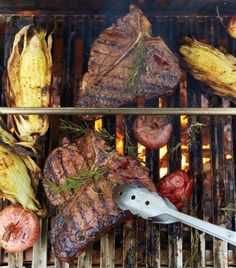Last week, we kicked off our “Get Grilling” series with tips on choosing meat. Now that you have your delicious, local, quality low FODMAP meat let’s talk about making it taste even better! We’re so excited to share with you four fabulous ways to build flavour in any meat that you would cook on your barbecue.

Marinade Basics: Oil + Acid + Seasoning
Marinades are usually made up of an oil (great time to use garlic-infused oil for a low FODMAP option!), an acid (wine, vinegar, tomato, citrus, yogurt), and other seasonings (spices, herbs, sauces, salt, and pepper). As we mentioned last week, grilling is a dry-heat cooking method, so the oil helps to create a nice juicy piece of barbecued meat! The acidic component works to breakdown proteins, leading to a more tender final product. And of course, adding spices, herbs, salt, and pepper will add more flavour. You’ll want to avoid or use small amounts of sauces like soy and Worcestershire as they can cause digestive distress. There are so many possible combinations! Be creative and enjoy!
The length of time you need to let the meat sit in the marinade depends on the type of meat, cut of meat, thickness of meat, and the acidity of your marinade. If meat is left in a very acidic marinade for too long, the window of tenderizing can be missed and you will end up with meat that is too tough or seafood that is too mushy. Here is a quick guide:
Marinade Time Chart
- Seafood: 15 – 30 minutes
- Tofu: 30 minutes
- Poultry (breast or thighs): 2 hours or overnight
- Poultry (whole): 4 – 6 hours or overnight
- Red meat: 2 – 4 hours or overnight
- Brisket: 24 hours
Food Safety Tips
- Keep your meat in the fridge when marinating, not out on the counter.
- Never reuse leftover marinade for another dish or reapply to the cooked meat to avoid cross-contamination of the bacteria from the raw meat.
- Don’t use a metal container because the acid in the marinade can react with the metal and create an unpleasant taste – use glass, plastic, or ceramic instead.

Rubs: Dried Spices
Rubs are a great way to add quick flavour if you don’t have the time to let meat sit in a marinade. You can purchase prepared rubs or simply pull together some spices and dried herbs to make your own! Many of these will have onion and/or garlic powder so it’s best to make your own. If you try store-bought varieties, simply stay mindful of your body to see if it contributes to symptoms.
Again, remember to be careful about contaminating the rub with the raw meat. Portion out a reasonable amount so that you aren’t placing anything that has been in contact with the raw meat into the container.
Sauces: Wait Until the End
The perfect barbecue sauce is essential for a classic summertime flavour. There are so many different styles of barbecue sauce, but they usually are a balance between savoury and sweet. The sweetness can be from added sugar, honey, maple syrup, molasses, or other sweet ingredients, that if added before cooking, tend to burn easily, causing a bitter taste. Wait until the last 5 to 10 minutes of grilling before slathering on the sauce. This will give you that nice caramelized flavour!
Put some of the sauce in a bowl and carry it out to the barbecue with a brush. This will ensure the rest of the sauce is safe to use for other dishes and that it isn’t contaminated by the raw meat. Use the brush to apply multiple layers of sauce near the end of the grilling time to build up an even glaze.
A lot of barbecue sauces contain ingredients that are high in FODMAPs. So we’ve put one together below for you to enjoy!
The first step if you’re looking to improve irritable bowel syndrome (IBS) or another digestive disorder or disease, is to understand more about the Low FODMAP diet and if it can help. Download my free eBook to help you better understand this diet and get started implementing simple steps to get rid of symptoms like gas, bloating, pain, diarrhea or constipation related to IBS. Click here to get a copy emailed to you right away.
Low FODMAP Recipe: Good for Your Gut Barbecue Sauce
INGREDIENTS
1/2 cup strained tomato puree
1/4 cup maple syrup
1 tbsp tamari (wheat or gluten free)
1 tbsp balsamic vinegar
1/4 tsp salt
1/4 tsp oregano
1/4 tsp smoked paprika
1/4 tsp ground coriander
1/8 tsp ground cumin
OPTIONAL: 4 chipotle peppers in adobo sauce **this ingredient has not been evaluated for FODMAPs, however you may be able to tolerate in small amounts in this recipe, since you would use just a little. These peppers add a whole lot of flavour, but you could substitute with other peppers if you like, i.e. roasted red peppers for a mild BBQ sauce
INSTRUCTIONS
Add all ingredients to a blender or food processor. Blend until smooth. Keep chilled.
Plank Grilling: Subtle, Smoky Flavour
You know that delicious, fresh wooden smell of saunas? Well, that’s what you get to enjoy when barbecuing on wooden planks. Barbecuing meat on an untreated wooden plank such as cedar, maple, or hickory, gives you a light flavour that you can enhance with a glaze. We tested two different glazes on salmon barbecued on cedar plank! Wooden planks must be soaked for at least one hour before grilling to add moisture to prevent it from catching on fire. Make sure it is completely submerged! Try adding ½ cup to 1 cup of wine, cider, or juice of a citrus to the soaking water to build even more flavour.
Once the salmon is marinated, it can be placed right onto the soaked plank and put directly on the barbecue. Keep the lid of the barbecue closed as much as possible throughout the grilling process to maximize smoking.
We used a lemon (1/2 lemon, sliced), salt (1 tsp), and pepper (1 tsp) glaze for one, and a maple syrup (1/4 cup) and whole seed Dijon mustard (2 tbsp) glaze for the other. After about 20 minutes, they were finished and ready to eat! Initially, the cedar taste is very mild, but if you let the fish cool on the plank, you will get a more aromatic effect.
Much love & good eating,
Stephanie


